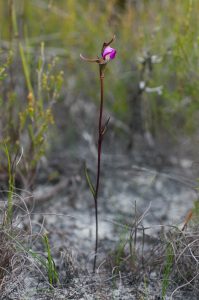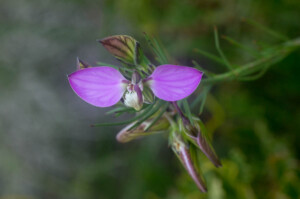Grandmothers these days rarely wear bonnets but the idea of a granny’s bonnet is familiar to most people. A piece of lacy cloth wrapped around the head, with a broad rim at the front. The name is used as a common name for a number of plants with hooded flowers. In South Africa it is applied to certain orchids, albeit usually with the Afrikaans version moederkappie. We have already described one, the bloumoederkappie, Disa purpurascens, but the commonest orchid that goes by the name granny’s bonnet is Disperis capensis.

Hooded flower of Disperis capensis with swept back sepals

Plant of Disperis capensis
Disperis capensis is a very distinctive orchid with a large purple hood with two long spurs that stick out the side and are strongly curved backwards (just perfect for tying the hood on the head). These two spurs are highly modified side sepals and give the genus Disperis its name. The sepals form a pouch and the generic name is derived from the Greek for two (dis-) pouches (-peris). There is only a single flower per spike and 2 leaves along the stem; characters that help to distinguish it from other species of the genus, though confusion is unlikely.
Deceptive Pollination
Like many orchids, Disperis capensis produces no reward for insects but deceives its pollinators into visiting the flowers. Research has shown that it is pollinated by carpenter bees of the genus Xylocopa. It achieves this by mimicking flowers of the genus Polygala. These also have large purple petals of a very similar size and colour, and the mimicry is enhanced by the central boss of white. But the shape is quite different so it is surprising that the bees are so easily fooled. At Phillipskop both Disperis capensis and the large-flowered Polygala umbellata are common. Although their flowering overlaps, Disperis capensis starts flowering a few weeks before Polygala umbellata. It therefore gets first call on the bees before they hone their skills at detecting what a rewarding Polygala flower looks like.

Disperis capensis deceives would-be pollinators of Polygala umbellata





